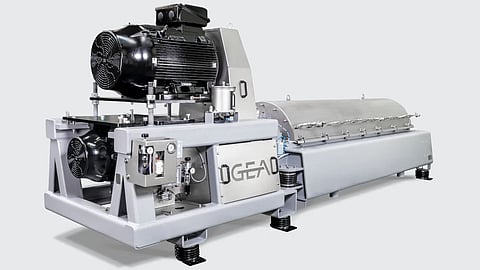
- Home
- EventsEvents
- Product Launches
- CategoriesCategories
- Advertise
- Opinion

The increasing importance of starch derived from various raw materials for the food and other industries requires innovative solutions for efficient processing. With the starchMaster CF 8000 decanter, GEA is responding to the growing global market for starch and starch products. According to Euromonitor, this market is expected to reach a volume of over 129 billion US dollars by 2030. The new decanter has been specially optimized for high-throughput starch extraction and gluten separation and is already being used successfully by European users following convincing tests. The high-performance starchMaster CF 8000 can be used for both 2-phase and 3-phase processes and offers a capacity of 15-20 tons of wheat flour equivalents per hour.
Optimization for market launch
The CF 8000 decanter comes standard with the GEA summationdrive, whose frequency-controlled motors automatically and seamlessly adjust the differential speed according to the solid load. Since the intensive starch processing is often associated with high differential speeds and torques of the decanter and thus with considerable gearbox loads, the starchMaster CF 8000 has been proactively equipped with a cooling system. This ensures reliable gear operation even under the most extreme conditions.
Efficiency improvement with Active Torque Control and varipond C
Additionally, the CF 8000 decanter offers an optional Active Torque Control (ATC) system. This GEA solution provides precise, automatic adjustment of the differential speed through active torque control to maintain the optimal operating point while avoiding stick-slip. This not only maximizes solid yield but also minimizes energy costs for thermal drying. ATC also significantly reduces the risk of machine damage from stick-slip, contributing to more efficient and sustainable production.
The starchMaster CF 8000 also features the new GEA varipond C system, allowing flexible adjustment of the separation zone within the decanter. This system is suitable for both 2-phase and 3-phase processes and enables quick response to changing feed conditions. With varipond, users can adjust the running decanter to changing requirements at any time, ensuring optimal separation results and stable solid discharge through variable pond depth.
Comprehensive condition monitoring and variable SLAs
The new GEA X Control and extensive condition monitoring capabilities for the starchMaster CF 8000 complete the package for this new decanter. By integrating the decanter into the cloud, operational data can be monitored in real time. Through customized Service Level Agreements (SLAs), GEA provides proactive service and maintenance with trained personnel to ensure maximum uptime and efficiency of the machines.
Info Box: What is the Stick-Slip Effect?
The stick-slip phenomenon is a detrimental effect that can occur in industrial machines like decanter centrifuges – irrespective of manufacturer and design – when the static friction between the solid bodies moving against each other is greater than the dynamic friction. If the slipping speed of the solid body becomes too slow, it gets stuck and needs additional energy to start slipping again. The stick-slip effect cannot be detected from the outside and leads to increased fatigue and wear to machine components such as the bowl, scroll, gearbox, shafts and coupling. Stick-slip increases the risk of unplanned, expensive downtimes with costly repairs.
Click HERE to subscribe to our FREE Weekly Newsletter
